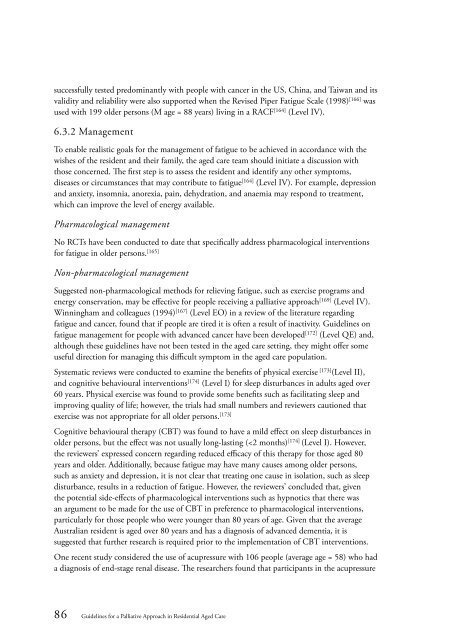Guidelines for a Palliative Approach in Residential Aged Care
Guidelines for a Palliative Approach in Residential Aged Care
Guidelines for a Palliative Approach in Residential Aged Care
You also want an ePaper? Increase the reach of your titles
YUMPU automatically turns print PDFs into web optimized ePapers that Google loves.
successfully tested predom<strong>in</strong>antly with people with cancer <strong>in</strong> the US, Ch<strong>in</strong>a, and Taiwan and its<br />
validity and reliability were also supported when the Revised Piper Fatigue Scale (1998) [166] was<br />
used with 199 older persons (M age = 88 years) liv<strong>in</strong>g <strong>in</strong> a RACF [164] (Level IV).<br />
6.3.2 Management<br />
To enable realistic goals <strong>for</strong> the management of fatigue to be achieved <strong>in</strong> accordance with the<br />
wishes of the resident and their family, the aged care team should <strong>in</strong>itiate a discussion with<br />
those concerned. The first step is to assess the resident and identify any other symptoms,<br />
diseases or circumstances that may contribute to fatigue [164] (Level IV). For example, depression<br />
and anxiety, <strong>in</strong>somnia, anorexia, pa<strong>in</strong>, dehydration, and anaemia may respond to treatment,<br />
which can improve the level of energy available.<br />
Pharmacological management<br />
No RCTs have been conducted to date that specifically address pharmacological <strong>in</strong>terventions<br />
<strong>for</strong> fatigue <strong>in</strong> older persons. [165]<br />
Non-pharmacological management<br />
Suggested non-pharmacological methods <strong>for</strong> reliev<strong>in</strong>g fatigue, such as exercise programs and<br />
energy conservation, may be effective <strong>for</strong> people receiv<strong>in</strong>g a palliative approach [169] (Level IV).<br />
W<strong>in</strong>n<strong>in</strong>gham and colleagues (1994) [167] (Level EO) <strong>in</strong> a review of the literature regard<strong>in</strong>g<br />
fatigue and cancer, found that if people are tired it is often a result of <strong>in</strong>activity. <strong>Guidel<strong>in</strong>es</strong> on<br />
fatigue management <strong>for</strong> people with advanced cancer have been developed [172] (Level QE) and,<br />
although these guidel<strong>in</strong>es have not been tested <strong>in</strong> the aged care sett<strong>in</strong>g, they might offer some<br />
useful direction <strong>for</strong> manag<strong>in</strong>g this difficult symptom <strong>in</strong> the aged care population.<br />
Systematic reviews were conducted to exam<strong>in</strong>e the benefits of physical exercise [173] (Level II),<br />
and cognitive behavioural <strong>in</strong>terventions [174] (Level I) <strong>for</strong> sleep disturbances <strong>in</strong> adults aged over<br />
60 years. Physical exercise was found to provide some benefits such as facilitat<strong>in</strong>g sleep and<br />
improv<strong>in</strong>g quality of life; however, the trials had small numbers and reviewers cautioned that<br />
exercise was not appropriate <strong>for</strong> all older persons. [173]<br />
Cognitive behavioural therapy (CBT) was found to have a mild effect on sleep disturbances <strong>in</strong><br />
older persons, but the effect was not usually long-last<strong>in</strong>g (
















